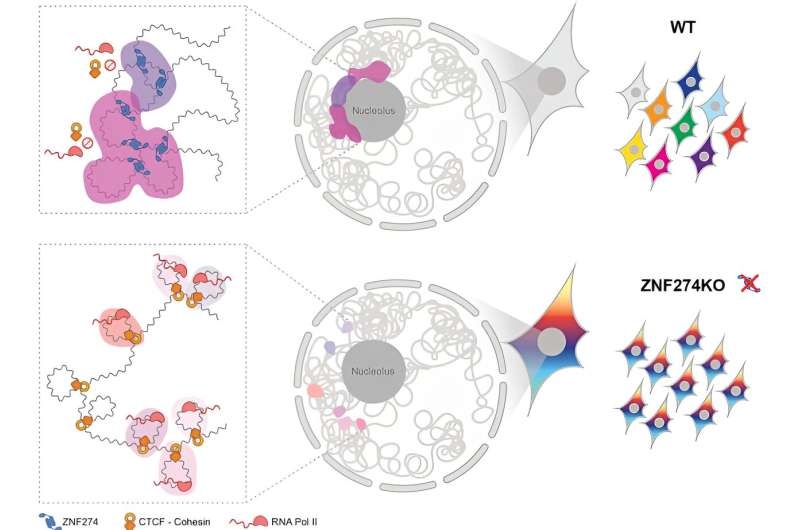Discover how the protein ZNF274 plays a crucial role in silencing specific gene clusters by anchoring them to the cell’s nucleolus, shedding light on the complex mechanisms behind gene regulation and their implications for understanding developmental disorders and diseases.

Unraveling the Nucleolus’s Hidden Talents
The cell’s nucleolus has long been known as the site of ribosome production, but recent studies have revealed its unexpected role in regulating gene expression. This spherical structure within the nucleus serves as a hub for repressing, or ‘silencing,’ certain gene clusters by hosting them in specialized regions called nucleolus-associated domains (NADs).
Scientists have been puzzled by the mechanisms that target specific gene clusters to these NADs, which is crucial for proper cell function and development. Understanding this process could provide valuable insights into diseases where gene repression goes awry, such as developmental disorders and cancers.
ZNF274: The Protein that Keeps Genes in Check
A team of researchers at EPFL has now uncovered a critical piece of the puzzle: the protein ZNF274. This protein serves as a bridge between the NAD components and certain gene clusters, recognizing a specific sequence motif within these genes.
By anchoring target genes, including those involved in neural development, to the NADs, ZNF274 ensures that these genes remain repressed, only turning on when they are supposed to. The researchers used a combination of CRISPR/Cas9 gene editing and advanced sequencing techniques to create cells lacking the ZNF274 protein, allowing them to study the effects on gene expression and genome organization.
Without ZNF274, the previously repressed gene clusters, such as those encoding protocadherins, became activated, leading to changes in the structure of chromatin and the 3D architecture of the genome. This finding underscores the critical role of ZNF274 in maintaining the silencing of specific gene groups, a process essential for proper cell function and development.
Conclusion
The discovery of ZNF274’s role in keeping certain gene clusters repressed by anchoring them to the cell’s nucleolus has far-reaching implications for our understanding of gene regulation. This knowledge not only advances our basic understanding of these fundamental biological processes but also suggests that disruptions in this system could contribute to a range of developmental disorders and diseases where gene regulation is known to be affected. As researchers continue to unravel the complex mechanisms behind gene expression, studies like this one provide valuable insights that may one day lead to new therapeutic approaches for conditions where gene dysregulation plays a role.
